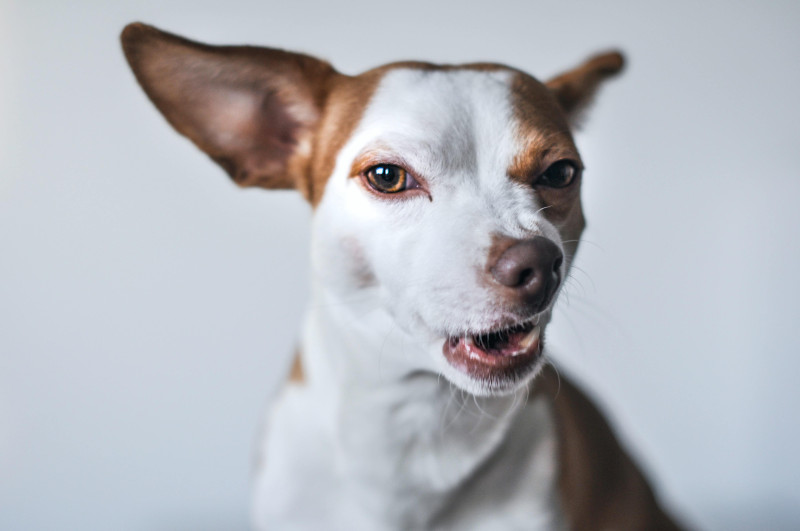How To Spot Fear Aggression In Dogs

You have likely heard of the fight or flight response that people have to situations or events that are frightening or stressful. Well, dogs can also have this reaction. When a dog feels scared, it will typically run away or hide if it can or become submissive or aggressive out of fear.
Dogs can express aggression towards people, other animals, or even objects as a form of self-defence when they feel threatened. This is known as fear aggression.
Fear is one of the most common causes of aggression, but it can sometimes be difficult to spot whether a dog is being aggressive due to fear or something else. If you suspect that a dog may be exhibiting fear aggression, read on to find out the signs and what to do if they are.
What are the causes of fear aggression?
One of the common causes of fear aggression is inadequate or improper training. Inhumane training using punishment-based techniques will likely have an adverse effect and invoke fear in your dog which can lead to aggressive behaviour.
If you have a rescue dog or a dog that you have rehomed, then they may exhibit fear aggression due to trauma as a result of the way they were raised or a past experience. For example, they may have a fear of going to the vets or groomers.
A lack of socialisation during a dog’s development can also be a root cause of fear aggression. Dogs that have not been properly socialised are likely to find it difficult to cope with new encounters or being around other dogs, animals, or people.
Dogs can also become aggressive due to fear when they are startled or surprised, such as by sudden, fast or unexpected movements or sounds, or when they are woken up suddenly, approached by a stranger or in a confined space, or seeing someone they know but that looks or acts different to usual.
How to spot fear aggression
Aggressive dogs typically growl, bark, snarl, snap and bite. Before a fear aggressive dog does any of these things, they will exhibit warning signs of being frightened or uncomfortable. If you can catch these warning signs early on, then you may be able to prevent this from developing into aggression.
Your dog’s body language should help you to determine whether they are fearful. Signs include a lowered or tucked tail, cowering or making themselves small, having their ears back, and wide eyes with dilated pupils.
Movement is another indicator of fear. If your dog is frozen stiff, standing still, hiding, avoiding contact, pacing, trembling, panting, or visibly agitated, then they are likely scared.
When something or someone is making a dog uncomfortable, the dog may become fixated on the perceived threat and stare at the person, animal or object intently, or they may avoid making eye contact and make darting glances.
A fearful dog may become disinterested in things they usually enjoy such as toys or treats, and not want to play or be petted.
If your dog is licking their lips, scratching or sniffing more than usual or when there does not seem to be any reason for it, they may be doing so out of fear or discomfort. These unusual or excessive behaviours are known as displacement behaviours. People can also exhibit these when nervous – instead they may play with their hair, tap their foot, fidget, or bite their nails.
How to combat fear aggression
If your dog is exhibiting signs of fear aggression, or if you are worried that your nervous dog will become aggressive, there are steps you can take to help deal with and prevent fear aggression.
Start by observing your dog to learn what they like and dislike, what they are scared of or feel threatened by, and what their normal behaviour is versus how they behave when fearful. This will help you to spot when something is wrong and to identify why, then prevent it from happening in future.
If there is something that you know your dog finds threatening, then keep your dog away from that person, animal or object, or avoid those situations, whenever possible. For example, if they are fearful of new people, then confine your dog to another room when you have visitors over.
If it is difficult to keep your dog away from a perceived threat or out of a situation, they find stressful, then try to create a positive association through toys or treats. For example, if your dog doesn’t like being around other dogs, give your dog treats as other dogs pass by on walks.
Make sure you remain calm and never punish your dog when they are fearful or aggressive. Your dog is aggressive because they are scared, so if you yell at them, hit them or pin them down, this will probably exacerbate the situation by making them more scared and increasing the likelihood of your dog lashing out.
If you continue to struggle to deal with or improve your dog’s behaviour, you should seek professional help as soon as possible.
Consult with your veterinarian to rule out any physical causes of aggression. They may suggest anti-anxiety products which you can get over the counter.
It is not likely that fear aggression will resolve itself over time or improve without proper training. For professional and tailored advice and training, WitsEnd is here to help. We have a team of professionals who will help you and your dog, through positive reinforcement training and expert advice.
Working with people from all over the country, we have had over 2000 success stories! To book an appointment or for more information, please call us on 0116 244 2455.